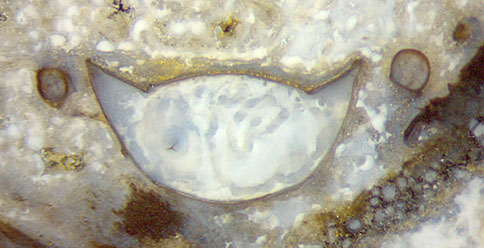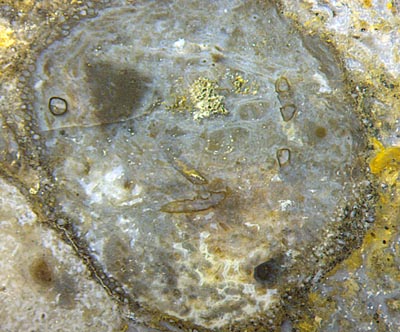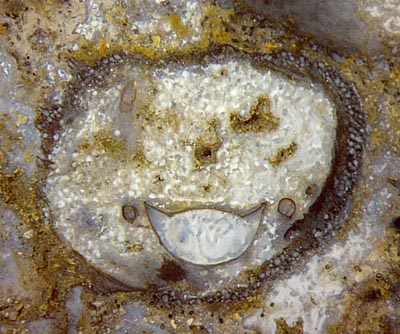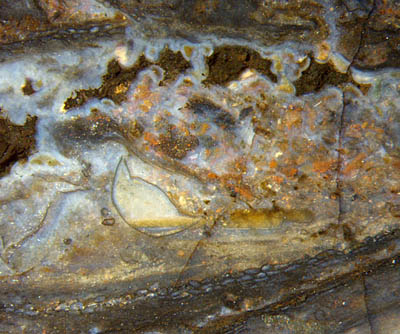Trigonotarbid
hiding places

What looks like modern artwork in Fig.1 is really moult
parts of
an early predatory arthropod known as trigonotarbid, most
probably incidentally arranged so that the symmetry seems wondrous. Trigonotarbids
are most easily recognized if incidentally seen
as cross-sections with characteristic outline, as in Fig. 1.
Fig.1: Trigonotarbid
moult parts, nearly symmetrically arranged. Image width 2.7mm.
Fig.2,3: Hollow
straws of Horneophyton
with trigonotarbid
moult parts. Image width 5mm.

 Apparently these creatures
usually crept into
broken hollow straws of
land plants, if available, as a protected hiding place for moulting
(Figs.2,3). This is also suggested by the presence of moult
parts of trigonotarbid
legs in the hollow straw in Fig.3, only 1cm beside the one
in
Fig.2. Possibly the creatures chose places with many broken hollow
straws as easily accessible hiding places.
Apparently these creatures
usually crept into
broken hollow straws of
land plants, if available, as a protected hiding place for moulting
(Figs.2,3). This is also suggested by the presence of moult
parts of trigonotarbid
legs in the hollow straw in Fig.3, only 1cm beside the one
in
Fig.2. Possibly the creatures chose places with many broken hollow
straws as easily accessible hiding places.
The
granular structure in Figs.1,2 is not the remains of tissue but the
result of spherulitic silicification in the watery fill.
Fig.4: Hollow
straw of Aglaophyton
with trigonotarbid moult parts.
Image width 5mm.

Although
Fig.4 is more confusing than the nearly circular sections in Figs.2,3,
a few facts can be derived: It is an inclined section of a formerly hollow
straw, successively filled as a result of various silicification
processes, with a trigonotarbid moult cross-section as a conspicuous
feature.
The
level surface of the fill at the bottom of the moult indicates that
there had been an intermediate fluid stage throughout the cavity of the
moult, where precipitates
had formed and settled into a heavy suspension with horizontal
surface. Two
small sections outside the big one seem to indicate that here, too, not
the creature as a whole but only its moult parts had become silicified.
Another trigonotarbid
"in hiding" is seen in Sociable trigonotarbids,
there Fig.1.
Samples: Figs.1-3:
Rh14/2 (6.3kg), obtained from Barron
in 2005, Part1; Fig.4: Rh9/58.2 (0.21kg), found by S. W. in
2004, Part2.
H.-J.
Weiss 2020
 |
 |
161 |




 Apparently these creatures
usually crept into
broken hollow straws of
land plants, if available, as a protected hiding place for moulting
(Figs.2,3). This is also suggested by the presence of moult
parts of trigonotarbid
legs in the hollow straw in Fig.3, only 1cm beside the one
in
Fig.2. Possibly the creatures chose places with many broken hollow
straws as easily accessible hiding places.
Apparently these creatures
usually crept into
broken hollow straws of
land plants, if available, as a protected hiding place for moulting
(Figs.2,3). This is also suggested by the presence of moult
parts of trigonotarbid
legs in the hollow straw in Fig.3, only 1cm beside the one
in
Fig.2. Possibly the creatures chose places with many broken hollow
straws as easily accessible hiding places. 

